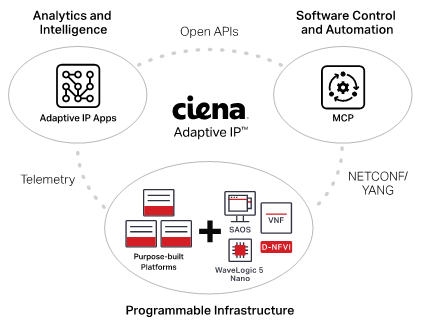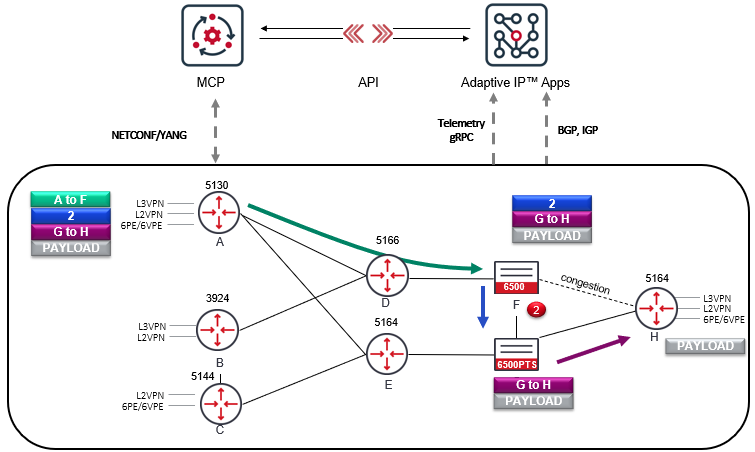Simplify your IP network with centralized Segment Routing, part of Ciena’s Adaptive IP
With the implementation of new technologies like 5G, the Internet of the Things (IoT), and Artificial Intelligence (AI), the need for increased computing capacity at the network edge is growing. This growth is putting increased strain on the IP connectivity and protocols that “glue” the Internet together.
“Simplicity is the ultimate sophistication” – Leonardo da Vinci
Supporting the necessary scale of IP nodes will require a new and innovative network architecture. IP networks must evolve to become much simpler to own and operate while leveraging automation and intelligence enabled through the adoption of Software-Defined Networking (SDN) capabilities.
Legacy approach won’t allow IP networks to cost-effectively scale
First, let’s take a step back and understand why the current approach won’t work. As an example, in a traditional IP-based network, packet forwarding decisions are made on a hop-by-hop basis with standalone routers performing route look-ups at every node. IP-based networks use Interior Gateway Protocols (IGP), designed to make packet forwarding decisions based on a preassigned path cost. Packets with similar origin and/or destination will follow the same route, resulting in congestion, even if optional paths are underutilized or even idle.
Trying to address this problem, Traffic Engineering (TE) was introduced and rather than forwarding decisions being made on a hop-by-hop basis, ingress routers determine the source-to-destination path for specific traffic flows. This way, traffic that would’ve previously taken a lower-cost yet congested path can now be directed via underutilized paths. In other words, perform traffic “load balancing”.
Resource Reservation Protocol (RSVP) was also introduced to reserve resources along the end-to-end path of traffic flow in an IP network. The RSVP signaling protocol was extended with Multi-Protocol Label Switch (MPLS) features to support MPLS-TE, enabling RSVP to set up a Label Switched Path (LSP) in an MPLS-TE network with RSVP-TE extension.
The current go-to technology for network operators to design and deploy traffic engineered MPLS networks is via the use of RSVP-TE.
The problem? Label Distribution Protocol (LDP), and specifically RSVP-TE, are complicated protocols to implement, maintain, operate, and troubleshoot when things go wrong. They create a lot of signaling traffic in the network, have a limited understanding of the topology, and flood the network with MPLS tunnels.
Network operators thus require highly skilled operations personnel to support an RSVP-TE network architecture and scaling a RSVP-TE networks can quickly become a daunting task!
Simplifying your network with Segment Routing
Segment Routing (SR) is a strong movement in the direction of IP network simplification. It isn’t a new technology, as vendors and service providers alike have been talking about it for close to a decade. However, initial discussions didn’t include SDN thereby significantly limiting its achievable benefits.
SR is a flexible and scalable way of implementing IP routing. The source chooses a path and embeds it directly into the packet header as an ordered list of links. An SR path isn’t dependent on hop-by-hop signaling, Label Distribution Protocol (LDP), or RSVP; rather, it uses “segments” for forwarding. Overall, a much simpler network to own and operate.
Segment Routing can also operate with an MPLS or an IPv6 data plane, and it integrates with the rich multi-service capabilities of MPLS, including Layer 3 VPN (L3VPN) and Ethernet VPN (EVPN).
Ciena Adaptive IPTM Implementation of Segment Routing
Ciena Adaptive IP presents the perfect architecture to evolve the network into a scalable, efficient, simplified, and cost-effective architecture leveraging Segment Routing. Adaptive IP is designed to embrace SDN and benefits from balancing between network-based distributed intelligence and centralized controller-based intelligence.
Evolving IP networks to a simpler and more efficient state with SR is not about having an SR-enabled network infrastructure or enabling SR in a legacy IP infrastructure. It demands a clear and widely proven strategy around implementing an intelligent automation platform. It requires the capabilities of Ciena Adaptive IP with:
- Open disaggregated programmable infrastructure with the ability to provide real-time telemetry, using open standards like gRPC, OpenConfig, and BGP-LS. Ciena Platforms, such as the 39xx, 51xx, 81xx, 6500-T and 6500PTS are excellent examples of solutions that unite scalability, performance, capacity, and a streamlined IP stack in an optimized form factor.
- Analytics with the ability to understand multi-layer and multi-vendor networks, performing network forensics, topology discovery, real-time network resource utilization, QoS requirement, and acts as an SR Path Computation Element (PCE). Adaptive IP Apps offers the perfect toolset to support any SR implementation.
- A domain controller with the capacity to automate and program the network infrastructure following PCE computation, using standards like NETCONF/YANG to implement the Segment Routing policies. Ciena Manage, Control and Plan (MCP) brings the SDN capabilities required for an effective SR deployment.

What should you know when evolving to Segment Routing?
When comparing SR to legacy IP Routing, LDP, and RSVP-TE implementations, the benefits are quite clear. Segment Routing has strong potential to become the main IP network architecture supporting use cases such as impending 5G mobile network deployments.
Some important things to remember when discussing any SR adoption:
- The evolution of IP networks is not a greenfield scenario. The majority of existing platforms already deployed aren’t compatible with SR. Any implementation will need to support a multi-technology environment.
- The only way to evolve networks to become adaptive, cost-effective, and futureproof is to embrace the openness mindset and associated solutions in the market. All building blocks in an SR implementation must support a multivendor environment.
- Finally, SR is not a box-centric implementation. Its efficiency is significantly dependent on having an intelligent automation software platform that aligns with the most advanced industry practices and has a clear evolution strategy.

Segment Routing Technology - implementation of Adaptive IP
Network operators running IP/MPLS networks need the ability to evolve their existing network infrastructure to support new service and the growth of the IP networks, without adding complexity and negatively impacting the Total Cost of Ownership (TCO). Ciena’s Adaptive IP is the perfect framework for a successful SR implementation.


